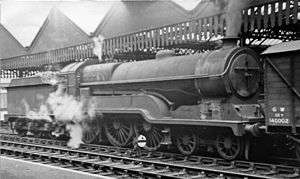GCR Class 1
| GCR Class 1 LNER Class B2 (later B19) | |||||||||||||||||||||||||||||||||||||||||||||||||||||
|---|---|---|---|---|---|---|---|---|---|---|---|---|---|---|---|---|---|---|---|---|---|---|---|---|---|---|---|---|---|---|---|---|---|---|---|---|---|---|---|---|---|---|---|---|---|---|---|---|---|---|---|---|---|
 Nameless No. 1492 (ex 427 City of London) at Sheffield Victoria, 17 July 1947 | |||||||||||||||||||||||||||||||||||||||||||||||||||||
| |||||||||||||||||||||||||||||||||||||||||||||||||||||
| |||||||||||||||||||||||||||||||||||||||||||||||||||||
| |||||||||||||||||||||||||||||||||||||||||||||||||||||
| |||||||||||||||||||||||||||||||||||||||||||||||||||||
The GCR Class 1 was a class of steam locomotives designed by John G. Robinson for the Great Central Railway, and introduced to service between December 1912 and 1913. In the 1923 grouping, they all passed to the London and North Eastern Railway who placed them in class B2. Their classification was changed to B19 in 1945, and all had been retired by the end of 1947.
Service
Although commonly believed that they were intended as express passenger locomotives, the Great Central actually classified and used them as mixed traffic locomotives. The minutes of the Locomotive Committee show that they were ordered as a superheated version of the 8F (Immingham) class mixed traffic locomotives. They were described as mixed traffic locomotives in the contemporary Great Central publication 'Per Rail' which promoted the company's goods services. When new, three of the class – 423, 425 and 428 were painted in GCR's standard green passenger livery, while the other three – 424, 426 and 427 were painted in the lined black goods livery; all were green by the end of 1922.[2] Their initial allocations included the 'Pipe trains', the vacuum-brake fitted express goods services between Manchester and London, among the most important services on the Great Central. There is no evidence that they were intended to challenge the contemporary 11E (Director) class 4-4-0s for the generally light express passenger services of the pre-1914 years on the London Extension.
Alleged problems
There is similarly no evidence to support the claims that they had problems in service which led to their alleged demotion from express passenger use. The design of the fire grate and ash pan was very similar to, for example, the later Gresley K3 2-6-0s, and their fireboxes were deep and relatively large for their 26.5 square feet (2.46 m2) grate area. Overheating troubles with axleboxes have been alleged, related to the large force from the inside cylinders. Robinson in fact took care to make the coupled boxes as large as possible, 9 by 9 inches (229 mm × 229 mm) on the two leading axles and 8 by 12 inches (203 mm × 305 mm) on the trailing set. In fact a more likely source of initial trouble was the marine-type big ends fitted to the first five, since the sixth reverted to strap and cotter type.
Numbering
| Built | GCR No. | LNER No. | LNER 1946 No. | Name | Withdrawn |
|---|---|---|---|---|---|
| December 1912 | 423 | 5423 | 1490 | Sir Sam Fay | April 1947 |
| January 1913 | 424 | 5424 | — | City of Lincoln | November 1945 |
| February 1913 | 425 | 5425 | 1491 | City of Manchester | July 1947 |
| March 1913 | 426 | 5426 | — | City of Chester | December 1944 |
| March 1913 | 427 | 5427 | 1492 | City of London[lower-alpha 1] | November 1947 |
| December 1913 | 428 | 5428 | 1493 | City of Liverpool | April 1947 |
References
- 1 2 3 Boddy et al. 1975, p. 12.
- ↑ Boddy et al. 1975, p. 10.
- ↑ Boddy et al. 1975, p. 15.
- Per Rail. Kingston-on-Thames: Knapp, Drewett & Sons. 1913. Missing or empty
|title=(help) - Boddy, M. G.; Brown, W. A.; Fry, E. V.; Hennigan, W.; Hoole, Ken; Manners, F.; Neve, E.; Platt, E. N. T.; Proud, P.; Yeadon, W. B. (March 1975). Fry, E. V., ed. Locomotives of the L.N.E.R., Part 2B: Tender Engines—Classes B1 to B19. Lincoln: RCTS. ISBN 0-901115-73-8.
- Casserley, H.C.; S. W. Johnson (1974) [1966]. Locomotives at the Grouping 2: London and North Eastern Railway. Shepperton, Surrey: Ian Allan Limited. ISBN 0-7110-0553-2.